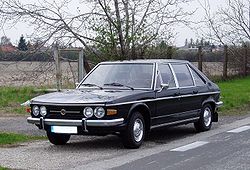| Tatra 613 | |
|---|---|
 | |
| Overview | |
| Manufacturer | TATRA, a. s. |
| Production | 1974–1996 |
| Assembly | Czechoslovakia/Czech Republic: Příbor, Moravia |
| Designer | Vignale |
| Body and chassis | |
| Class | Full-size luxury car |
| Body style | 4-door sedan |
| Layout | RR layout |
| Powertrain | |
| Engine | 3.5L Tatra 613 V8 |
| Transmission | 4/5-speed all-synchromesh manual floor-mounted gear change lever |
| Dimensions | |
| Wheelbase | 2,980 mm (117.3 in) |
| Length | 5,020 mm (197.6 in) |
| Width | 1,800 mm (70.9 in) |
| Height | 1,500 mm (59.1 in) |
| Curb weight | 1,690 kg (3,726 lb) |
| Chronology | |
| Predecessor | Tatra 603 |
| Successor | Tatra 700 |
The Tatra 613 is a large luxury rear wheel driven car with rear-mounted air-cooled engine manufactured by Czechoslovak manufacturer Tatra from 1974 until 1996 as a replacement for the Tatra 603 series.
Contents
It featured an all-new body styled by Vignale of Italy back in 1968 [1] and used a DOHC air-cooled 3.5 litre V8 engine with 168 PS (124 kW). [2] Later injection versions reached 200 PS (147 kW), with a maximum speed of 230 km/h (143 mph). The design was updated a further five times until being replaced by the Tatra 700 in 1996, itself a restyled T613-5.
The Tatra 613 vehicles were mostly used by government officials, industry executives and in limited numbers were also used as police cars and as the rapid response fire fighting and rescue vehicles during motorsport events.





